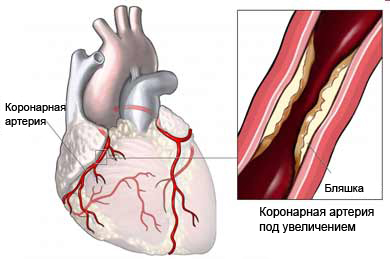Acute coronary syndrome – Unstable angina
Description of acute coronary syndrome
Acute coronary syndrome (OKS) – term, that describes the symptoms, associated with poor blood flow to the heart muscle. This results in chest pain, or angina. Angina – a very serious disease. Acute coronary syndrome can be life-threatening. If there is a suspicion of ACS, urgently need to undergo treatment.

Causes of acute coronary syndrome
Acute coronary syndrome is caused by narrowing of the coronary arteries. The blood from these blood vessels is delivered to the heart muscle. Blood flow to the heart muscle or significantly decreases, or completely blocked. This leads to heart failure and death.
Sometimes cause narrowing of the arteries can blood clots. The narrowing most often happens when an artery plaque build-up. This process is called atherosclerosis.
Risk factors for acute coronary syndrome
Factors, that increase the likelihood of acute coronary syndrome:
- The presence of heart disease in the family (heredity);
- Age: Men More 45 years; for more women 55 years;
- Being overweight or obese;
- Smoking;
- High cholesterol, particularly high “bad” cholesterol and low “good” cholesterol;
- High blood pressure;
- Diabetes;
- Sedentary work or lifestyle;
- The presence of angina, previous heart attack, or other types of ischemic heart disease.
Symptoms of acute coronary syndrome
ACS is very dangerous and requires immediate treatment. It is necessary to go to the hospital with the appearance of some of the symptoms:
- Angina – chest pain, pressure, burning, or other unpleasant symptoms, which may take a few minutes, disappear, and then appear again; often occur after physical exertion, emotional stress or a heavy meal;
- Unstable angina – often encountered while in state of rest, sleep, or a small voltage, It can last up to 30 minutes;
- Pain or discomfort in one or both hands, shoulders, back, neck, jaws, or stomach;
- Breathlessness, which is accompanied by chest pain or may occur just before it;
- Feeling dizzy;
- There may be nausea and vomiting;
- Often there is increased sweating.
Diagnostics
For suspected acute coronary syndrome performed a physical examination of the patient, and the following tests:
- Electrocardiogram (ECG or EKG) - Measures the level and heart rate; can show damage, caused to the heart muscle;
- Blood tests, to measure the level of enzymes, including:
- Analysis of troponin – the most accurate analysis; can determine, whether a heart attack and how strong he was;
- Determining the level of creatine kinase in the blood;
- Analysis of myoglobin – availabilty of myoglobin in the blood;
- Nuclear heart scan – radiotracers outline channels and cardiac blood vessels near the heart;
- Heart catheterization – can determine pressure and blood flow within the heart, collect blood samples, and examine the arteries of the heart;
- Coronary angiography – Analysis of blood flow through the heart, shows, where there is a delay;
- Echocardiogram – analysis, which uses sound waves, to create a moving picture of the heart;
- Chest X-ray - the image inside of the chest, to estimate the size of the heart, and, perhaps, detect pneumonia in the lungs.
Treatment of acute coronary syndrome
In the event of a heart attack, the physician must:
- Quickly restore blood flow to the heart;
- Closely monitor vital signs to detect and treat complications.
To restore blood flow, perform the following basic procedures:
- Take aspirin;
- For ease of ischemic chest pain to take the necessary preparations, such as nitroglycerin;
- To dissolve the blood clots apply thrombolytic drugs. When taken after the start of heart attack, these drugs may limit or prevent permanent damage to the heart. To improve their effectiveness, they must be taken within one hour after the start of heart attack symptoms. Some of thrombolytic agents:
- Eptifiʙatid;
- Tirofiʙan;
- Glycoprotein Iib / IIIa receptor antagonist.
Angioplasty – catheter with an inflatable balloon is introduced into the blocked artery. The balloon is inflated and expands the blood vessels, restoring normal blood flow. Inside the vessel the stent can be placed – wire design, not giving vessels constrict.
Coronary artery bypass grafting – artery or vein is taken from other parts of the body, and used, to bypass blocked arteries.
Treatment of ACS with angiography and revascularization (restoration of blood flow to the heart) can reduce the level of hospitalization. But the operation does not reduce the chance of death or heart attack.
Prevention of acute coronary syndrome
To reduce the risk of acute coronary syndrome, you need to lead a healthy lifestyle, adhere to the following rules:
- Develop a balanced diet. It should be rich in fruits, vegetables, Krupa. Do not use products, containing a lot of fat.
- Conduct regular surveys;
- You must quit smoking;
- Is engaged in treatment of diabetes, normalize cholesterol. This may require some lifestyle changes.
